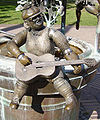Ludwigsplatz (Ludwigshafen)
The Ludwigsplatz is a central but little busier place in Ludwigshafen , which is equipped with a sculptural ensemble.
Development
Characteristic of the centrally located square are the old plane trees , which can already be seen in photos at the end of the 19th century, when the square was still holding a market and the former Ludwigshafen terminus station was in the immediate vicinity . The plane trees are already drawn in on a plan sketch from around 1880, after the "Beautification Association" had 120 plane trees planted in 1879.
Except for the former 1950s-style Café Laul (at the northern end), the square is vacant. Around the square there are two bank buildings, a hotel, the Rhein-Center and other buildings. In addition, a tram line runs through Ludwigsplatz, the tracks of which are laid in a lawn.
Sculptures
Palatinate joie de vivre
Palatinate joie de vivre is the name of a fountain that was created by the Aachen artist Bonifatius Stirnberg in 1991.
Four figures stand for singing and making music, sports, celebrating parties and dancing. In the middle of the bronze sculpture there is a smiling sun supported by vines and grapes. This is to be understood as a reference to the Palatinate Summer.
The four moving figures on the edge are:
- The hunter from Electoral Palatinate
- A footballer ( Fritz Walter ?)
- The Hemshof-Friedel
- A dancer
Rainman
The Rainman is a bronze sculpture of a little boy. The sculpture is a gift from the neighboring city of Mannheim for the hundredth birthday of the city of Ludwigshafen in 1953. It was created by the artist Kurt Lehmann and shows a little boy holding an open book over his head to protect himself.
Ludwina
The figure of Ludwina sits on a pedestal with flower petals on the edge of a shallow well basin eight meters in diameter.
The fountain was donated by the Ludwigshafener Stadtsparkasse, which celebrated its centenary in 1988. The Stadtsparkasse chose Ludwigsplatz in front of its headquarters as the location for the fountain and appointed the Munich sculptor and art professor Erich Koch, who came from the Palatinate, to execute the fountain figure. The model for the three-meter-high bronze figure is a small sculpture that the cook designed beforehand in a cycle over the four seasons as a symbol for spring.
Several years passed before the plant was completed. The fountain was only finished after the conversion of Ludwigsplatz for the Rhineland-Palatinate Day in 1992.
The name "Ludwina" should allude to the name of the city of Ludwigshafen, the fountain itself should create a reference to the city on the water.
Ice skater
The ice skater comes from the Italian sculptor Giacomo Manzù . It was created in 1957 as a characteristic example of late impressionism . The ice skater presents herself as a slim, towering girl figure on a bronze plinth that accentuates the long legs. The vertical elongation gives the figure a certain severity.
Flying genius
The Flying Genius by the German sculptor Georg Kolbe from 1928 is an idealistic nude sculpture that shows a heroic gesture.
Pillar of light
In 2002, the Dutch artist Jan van Munster designed a 22-meter-high light column for the Sparkasse Vorderpfalz on Ludwigsplatz and the 38-meter-long brainwave for the bank's glass hall . Reflections in the glass facade of the hall allow the two light works to enter into a direct relationship. Jan van Munster derived the horizontally applied brainwave from the recording of his own brain waves.
Web links
literature
- Marlis Jonas (photos); Richard W. Gassen (text): “ KunstRaum Stadt. Public Art in Ludwigshafen am Rhein ”. Heidelberg: Kehrer Verlag, 2007.
- Stadtsparkasse Ludwigshafen am Rhein (ed.): " Sculptures and fountains in Ludwigshafen ". Ludwigshafen: 1996
Coordinates: 49 ° 29 '3.4 " N , 8 ° 26" 46.5 " E





















